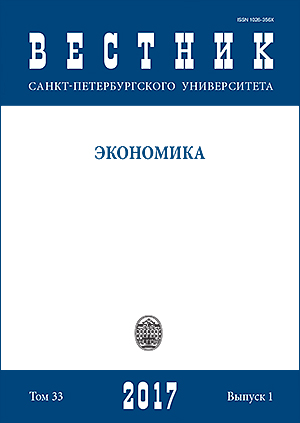Local Currency as a Way of Decentralization of Monetary Circulation
DOI:
https://doi.org/10.21638/11701/spbu05.2017.106Abstract
The article is devoted to the possible emergence in Russia of local money, as an instrument of regional development. Currently the country uses a universal currency — the ruble. The state has always sought to universalize economic activity, by reducing the number of economic agents — the objects control and increase the uniformity for the best (preferably total) control over economic and social sphere. Most clearly this control is now evident in developed countries, despite their professed liberalism.
The author puts forward the hypothesis that the ruble, despite its universality, has different purchasing power in different regions of Russia and because of this he can fully perform the functions of a universal currency. To prove the hypothesis the article presents a comparison of the purchasing power of the ruble in different regions of the country. It is made on the base “consumer basket” of Rosstat (83 goods and services) and the regional average annual income. As a result, the assumption of unequal purchasing power of the ruble was confirmed in the author’s model for its calculation. To many it seems self-evident, but, nevertheless, this is probably the first publication where an attempt is made to explain the unequal purchasing power of the currency.
Local money issued by local authorities, as subsidiary currency, could involve not currently used to the full extent of local material and human resources. Despite the fact that at the present time, such projects have a low chance of being implemented, it can be assumed that in the future, along with the growing fiscal problems at the higher levels of government, they could have a much greater chance of success.
Keywords:
money, monetary system, parallel currency, local currencies, a universal currency, the purchasing power of the ruble, monetary surrogates, LETS, Ithaca hour
Downloads
References
References in Latin Alphabet
Translation of references in Russian into English
Downloads
Published
How to Cite
Issue
Section
License
Articles of the St Petersburg University Journal of Economic Studies are open access distributed under the terms of the License Agreement with Saint Petersburg State University, which permits to the authors unrestricted distribution and self-archiving free of charge.






